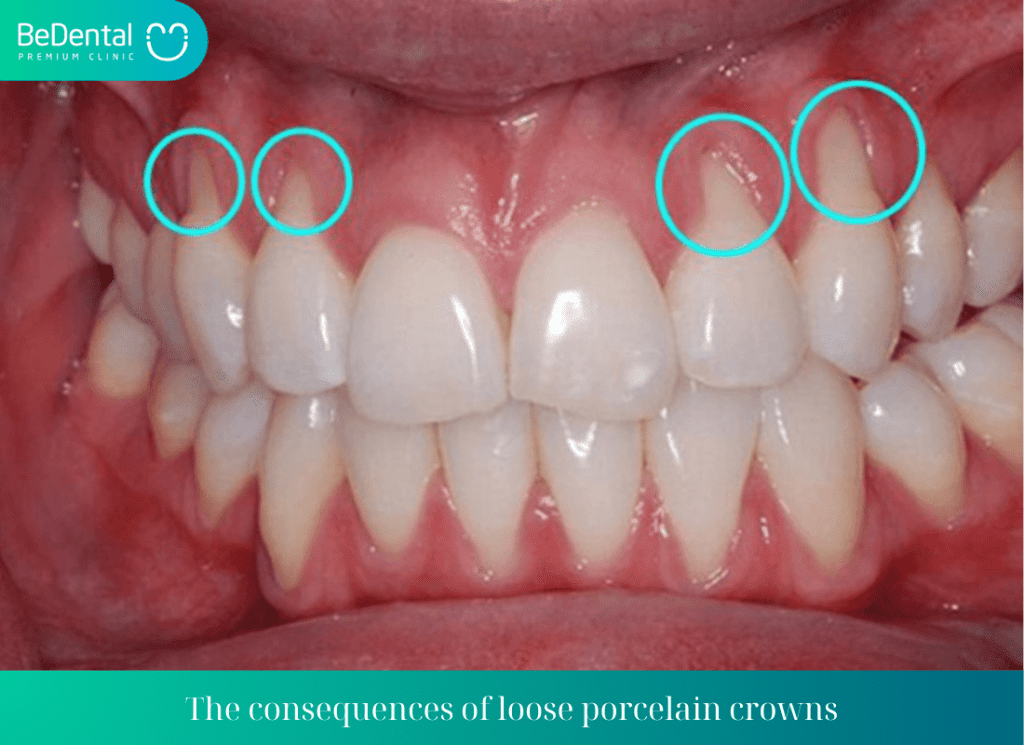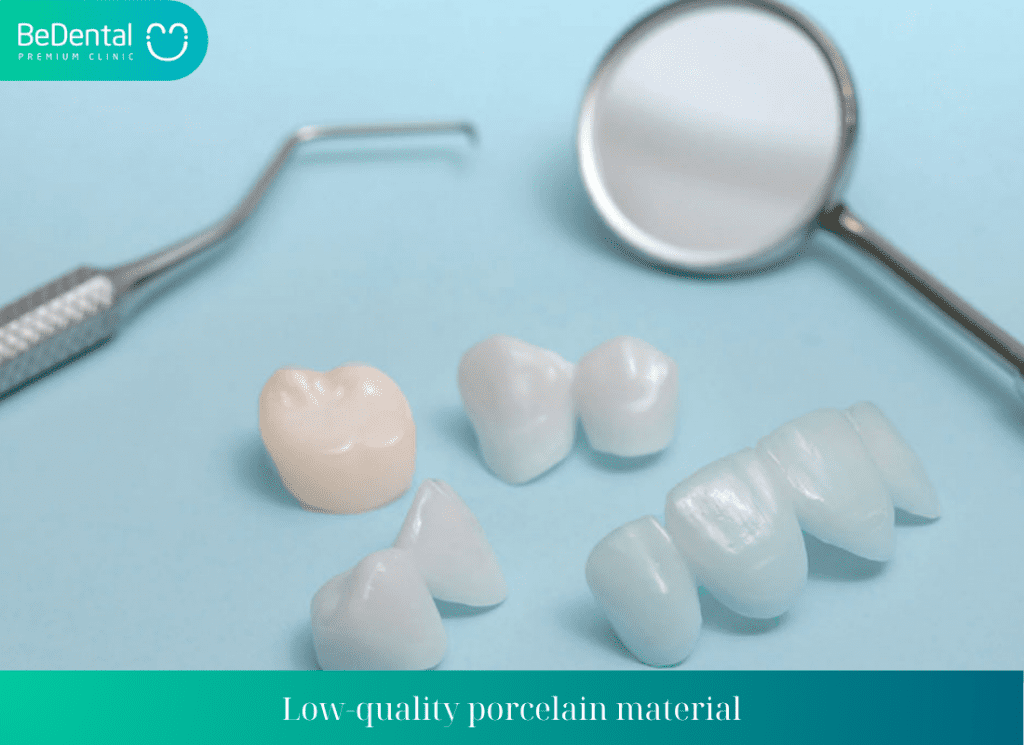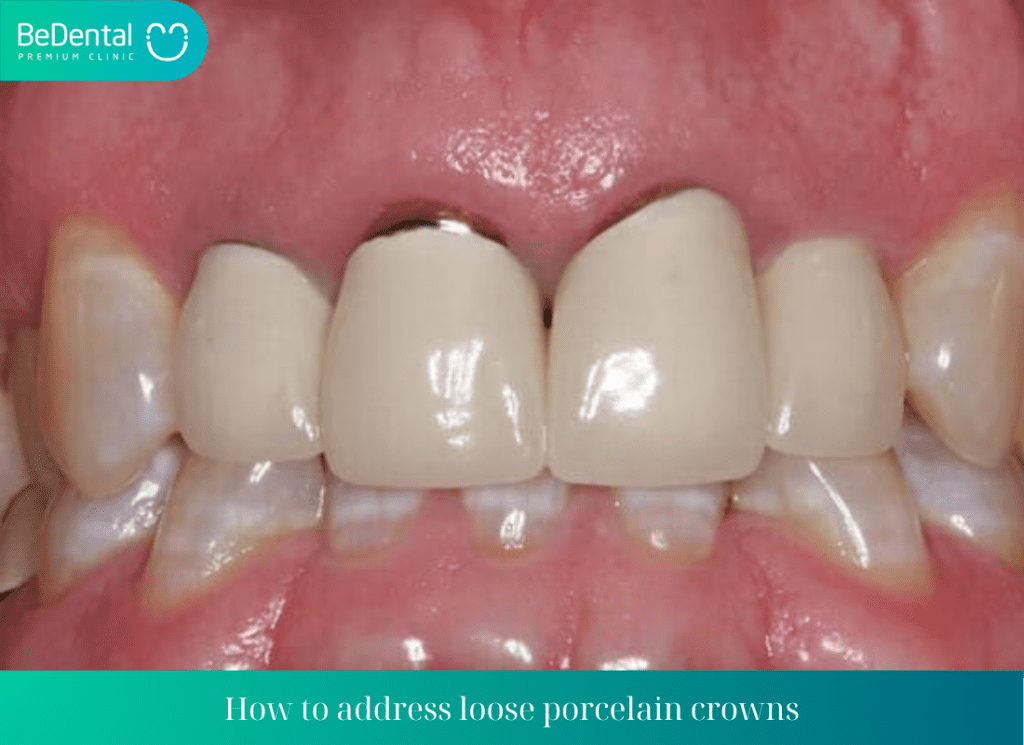After having porcelain crowns placed, there may be undesirable outcomes, such as the porcelain crowns becoming loose, causing gaps between teeth and weakening the strength of the teeth, as well as affecting the aesthetic appearance of the face. The reasons for the phenomenon of porcelain crowns becoming loose can be due to various factors, and it is necessary to find appropriate solutions. So, Do porcelain crowns cause gum recession? Let’s find out with BeDental in this article!
Do porcelain crowns cause gum recession?
Do porcelain crowns cause gum recession? Porcelain crowns may become loose if done at a non-reputable dental clinic with poor techniques. Because a highly skilled and properly trained dentist, when following the correct procedures, should not experience issues with porcelain crowns becoming loose. Along with that, if you follow proper techniques and maintain good oral hygiene after getting porcelain crowns, there should be no complications.
See more: How much does dental filling cost?

This method is highly regarded for its aesthetic and safety aspects. To feel confident when deciding to have porcelain crowns, you should thoroughly research reputable dental facilities before proceeding.
The consequences of loose porcelain crowns
What are The consequences of loose porcelain crowns? Porcelain crowns are an advanced cosmetic technique that can address various oral imperfections. They allow for adjustments in the shape and color of teeth to create a more harmonious and attractive smile. Most clients are satisfied with the results after getting porcelain crowns due to their aesthetic appeal and functional chewing capabilities similar to natural teeth.
See more: What is the appropriate age for braces?
However, in some cases, complications such as loose porcelain crowns may arise, causing concerns for clients. So, what issues can this condition pose to oral health? The most apparent sign of a loose crown is when the base of the tooth becomes exposed due to gum recession or movement of the crown towards the tooth’s tip. Accompanying symptoms may include redness, pain, and bleeding gums, easily noticeable to the naked eye.

If left untreated, complications from loose porcelain crowns can lead to the following potential issues:
- Gum recession causing the base of the tooth to be exposed, resulting in loss of tissue around the tooth and direct contact with the tooth’s nerve. This can make the tooth sensitive and prone to pain when in contact with food or during brushing.
- When the crown becomes loose, there is a risk of tooth decay due to direct contact with bacteria in the oral environment.
- Food may get stuck in the gap between the tooth and the porcelain crown, creating conditions for bacterial growth and causing issues like bad breath, cavities, gum inflammation, and periodontal disease.
- Damage to the gum tissue and bone structure surrounding the tooth can lead to tooth instability, making it more prone to movement or breakage.
- Reduced ability to eat and chew food, needing to restrict certain types of food and losing the enjoyment of eating.
- This condition also affects facial aesthetics, making the smile less attractive.
See more: Do i need braces for mild overbite?
Causes of loose porcelain crowns
What are the Causes of loose porcelain crowns? The technique of crowning requires high skills from the dentist and support from various technologies and equipment. If the process is not up to standard, it may lead to unexpected results and have a negative impact on oral health in the future.
A typical example is the occurrence of loose porcelain crowns, which can result from various causes:
Incorrect technique implementation, lack of skill
Inexperienced dentists may lead to improper tooth preparation and incorrect fitting of the porcelain crown. This can create gaps where food gets trapped, leading to gum recession and exposure of the nerve and tooth.
Improper sizing of the porcelain crown
Without modern dental technology and equipment, the process of taking impressions and crafting the porcelain crown may be inaccurate. This can result in an ill-fitting crown that does not match the tooth’s shape, does not fit snugly against the gums, and may cause it to become loose.
Low-quality porcelain material
Non-branded and unidentified porcelain crowns often have poor quality. Using them to crown teeth can lead to issues like irritation, infection, and the potential for crown loosening.

Failing to thoroughly treat oral diseases
In some dental offices, some dentists may be careless in their examinations or fail to detect diseases due to lack of experience. This can lead to incomplete treatment of health issues before placing porcelain crowns, increasing the risk of gum inflammation and recession.
Improper oral hygiene
Using a hard toothbrush, brushing teeth horizontally, or applying excessive brushing force can be common incorrect habits when cleaning teeth. This is one of the causes of gum damage, crown loosening, and potential crown exposure.
See more: At what age can children get braces?
How to address loose porcelain crowns
How to address loose porcelain crowns? When a porcelain crown becomes loose, handling cannot be done at home and requires a visit to reputable dental offices for treatment by skilled and experienced dentists.
Based on the cause of the crown loosening, we will provide appropriate treatment solutions:
- If the loosening is due to errors in the implementation technique or incorrect sizing of the porcelain crown, the dentist will remove the crown and design a new, more fitting one.
- If the loosening is due to untreated oral diseases, the dentist will remove the crown to treat the disease before reattaching it.
- If the loosening is due to the use of low-quality porcelain crowns, the dentist will remove the old crown and replace it with a higher-quality new porcelain crown, such as an all-ceramic crown.

In addition to these treatment methods, home oral care is also crucial to prevent the recurrence of crown loosening:
- Brush your teeth twice a day with a soft-bristled toothbrush.
- Gently brush your teeth in a vertical motion or circular motion.
- Use dental floss and mouthwash to clean leftover food particles.
- Visit the dentist for regular check-ups every 6 months for examination and treatment if necessary.
Choosing a reputable dental office is crucial to ensure that the porcelain crown treatment process is done correctly and safely. Be cautious of cheap porcelain crown advertisements that do not guarantee quality, as this can lead to crown loosening and various oral health issues.
See more: Why do gums swell when getting braces
Most asked questions
How often should I visit the dentist for check-ups and cleanings?
It is generally recommended to visit the dentist for check-ups and cleanings at least twice a year, or every six months. Regular dental visits help to prevent oral health issues, detect any problems early on, and maintain good dental hygiene.
However, the frequency of dental visits may vary depending on individual oral health needs and any specific conditions or concerns that may require more frequent monitoring or treatment. Your dentist can provide personalized recommendations based on your oral health status and needs.
Are there any home remedies for toothache relief
- Rinse your mouth with warm salt water to help reduce inflammation and kill bacteria.
- Apply a cold compress to the outside of your cheek near the painful tooth to help numb the area and reduce swelling.
- Clove oil, which has natural numbing properties, can be applied directly to the sore tooth or gums.
- Peppermint tea bags, when cooled and placed against the affected area, may help numb the pain.
- Over-the-counter pain medications like ibuprofen or acetaminophen can help alleviate toothache pain.
See more: Bone resorption when wearing braces
What is the difference between a dental crown and a filling?
- A dental filling is used to repair a small to medium-sized cavity or hole in a tooth caused by decay.
- Fillings are typically made of materials such as amalgam (silver-colored), composite resin (tooth-colored), gold, or porcelain.
- The filling material is placed directly into the cavity after removing the decayed portion of the tooth, restoring the tooth’s shape and function.
- Fillings are a less invasive and more conservative treatment compared to dental crowns.
- A dental crown, also known as a cap, is a custom-made restoration that covers the entire visible portion of a tooth above the gumline.
- Crowns are used to protect and strengthen a tooth that is significantly damaged, weakened, or has undergone a root canal treatment.
- Crowns can be made from various materials, including porcelain, metal, or a combination of both, depending on the location and function of the tooth.
- Crowns are more extensive restorations than fillings and provide more comprehensive coverage and protection for a tooth.
See more: Will braces cause protrusion?
Conclusion
In conclusion, maintaining proper oral hygiene and seeking timely treatment for oral diseases are essential in preventing issues like crown loosening. Regular dental check-ups, diligent home care practices, and selecting a reputable dental provider are key steps in ensuring the longevity and success of porcelain crown treatments. By following these recommendations and being mindful of potential causes and solutions for crown loosening, individuals can safeguard their oral health and enjoy the benefits of a healthy, functional smile.
Tư vấn chuyên môn bài viết:
BÁC SĨ DƯƠNG THỊ THÙY NGA





